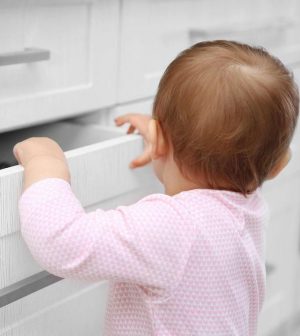- Navigating Your Midlife Crisis: Embracing New Possibilities
- City Raccoons Showing Signs of Domestication
- Mapping the Exposome: Science Broadens Focus to Environmental Disease Triggers
- One Week Less on Social Media Linked to Better Mental Health
- Your Brain Changes in Stages as You Age, Study Finds
- Some Suicide Victims Show No Typical Warning Signs, Study Finds
- ByHeart Formula Faces Lawsuits After Babies Sickened With Botulism
- Switch to Vegan Diet Could Cut Your Greenhouse Gas Emissions in Half
- Regular Bedtime Does Wonders for Blood Pressure
- Dining Alone Could Mean Worse Nutrition for Seniors
U.S. Kids Still Dying From Toppling TVs, Furniture

Before your eyes become glued to the Super Bowl or the Winter Olympics, make sure your TV and furniture are anchored to the wall to protect little ones from potentially deadly tip-overs.
Between 2018 and 2020, an average of 22,500 Americans a year required emergency department treatment for tip-over injuries, and nearly 44% were under 18, according to the U.S. Consumer Product Safety Commission (CPSC).
Since 2000, there have been nearly 600 tip-over deaths involving furniture, TVs or appliances, and 81% of those victims were children 17 and younger.
“People either don’t know about the risks, or they think it can’t happen when an adult is nearby,” said CPSC Chair Alex Hoehn-Saric.
According to the new CPSC report, 71% of all child deaths involved a TV; 62% of deaths in all age groups involved a TV; 55% of deaths involved people being crushed; and 66% of deaths resulted from head injuries.
In 2015, CPSC launched a campaign called AnchorIt! to educate Americans about the dangers of tip-overs. Between 2011 and 2020, there was a 55% decrease in tip-over injuries treated in U.S. emergency rooms, largely due to fewer TV tip-overs.
“We’re pleased to see the decrease in tip-over injuries over time,” Hoehn-Saric said in a commission news release.
Protection is inexpensive and easy to install, he said.
“Most anti-tip-over kits cost less than $20 and can be installed in fewer than 20 minutes,” Hoehn-Saric said. “We urge parents and caregivers to protect their children and families and make the time to secure heavy items in their homes.”
The CPSC offers these suggestions:
- Anchor TVs and furniture such as bookcases and dressers securely to the wall.
- TVs should be on a sturdy, low base and placed back as far as possible, particularly if they can’t be anchored.
- Don’t display or store items such as toys and remotes where kids may be tempted to climb to reach for them.
- Store heavier items on lower shelves or in lower drawers.
- When you buy a new TV, consider recycling your old one. If you move the older TV to another room, be sure it is anchored to the wall properly.
- Keep TV and cable cords out of children’s reach.
- Even when TVs and furniture are anchored, children should still be supervised by an adult.
More information
Safe Kids Worldwide has more about preventing tip-over tragedies.
SOURCE: U.S. Consumer Product Safety Commission, news release, Feb. 3, 2022
Source: HealthDay
Copyright © 2025 HealthDay. All rights reserved.










